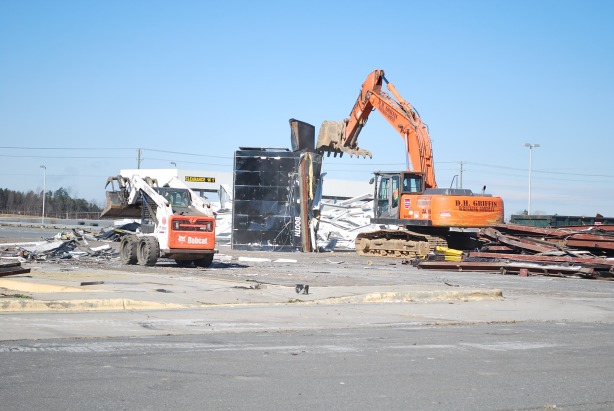Workers this week are removing the last vestiges of coal burning on the University of Georgia campus as workers dismantle and haul away tons of steel at the University of Georgia’s steam plant, where gas, oil and electric boilers generate steam to feed 7 miles of pipe buried beneath the UGA campus.
The steam heats and also cools about 100 UGA buildings, as well as feed such laboratory equipment as sterilizers.
After about a month of work cutting with torches and disassembling, workers with Demolition and Asbestos Removal Inc., have hauled away nearly 59 tons of steel, with about 19 tons now on the ground waiting to be shipped out. Those totals will rise much higher over the next two months before the job is finished, said David Spradley, UGA’s director of energy services. There’s no asbestos to be removed, he said.
After the Demolition and Asbestos Removal workers are finished removing the boiler and pollution-control equipment attached to it, a different set of contractors will install a new electrostatic boiler, which UGA facilities workers can shut on and off as needed, unlike the old coal plant, installed about half a century ago.
Once the temperamental coal boiler was turned on at the beginning of cold weather, it pretty much had to stay burning at least at a low level for the entire winter.
The $337,000 demolition project is part of a $4.5 million budget to replace the boiler, including $2.1 million to design and install a new electric transmission infrastructure, which will deliver power to the new electrostatic boiler from a UGA power substation. Another $2.4 million is earmarked for demolition plus the purchase and installation of the new boiler, Spradley said.
The new boiler is scheduled to be operational by November, well before January, when it’s likely to be needed first.
Athens air should be cleaner with the coal boiler gone, especially in winter and especially
in areas near the boiler and its smokestack.
The coal boiler was one of Athens’ largest stationary sources of air pollution, although automobiles and other vehicles are by far the largest contributor. In 2013, the boilers produced about 258 tons of sulfur dioxide and about 35 tons of particulate matter, according to reports UGA files with the state Environmental Protection Division.
Even natural gas, the main fuel for the boilers, produces some pollution. But the vast majority came from the coal boiler, Spradley said.
At one time, the coal boiler ran all year, but as UGA made its steam pipes more efficient over the past several years, the plant began operating just six months out of the year and then four months.

The change will also eliminate a big chunk of UGA’s landfill bill. The coal boiler generated about 10 tons of ash for every two days the boiler operated. Scrubbing and air cleaning systems that removed some pollution consumed about 22 tons of lime a month.


Overall, the electrode boiler will save UGA millions of dollars over the next three decades in operating costs and other expenses, Spradley said.
One thing will remain in place, at least for now – the tall smokestack that once vented exhaust from the boiler. University officials haven’t yet determined whether the smokestack should be considered an historic structure.
Follow education reporter Lee Shearer at http://www.facebook.com/LeeShearerABH or twitter.com/LeeShearer
By Lee Shearer
Mon, 22 Jun 2015, 05:01 AM
For the Full Story Check Out Online Athens Here











